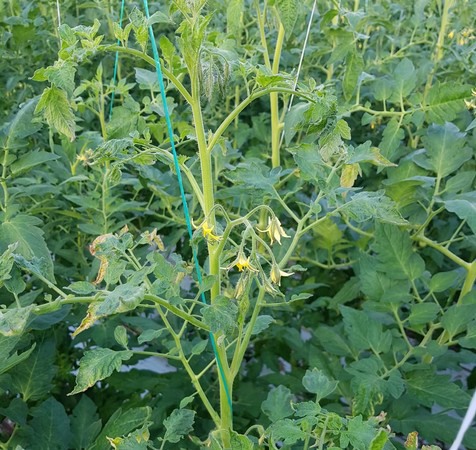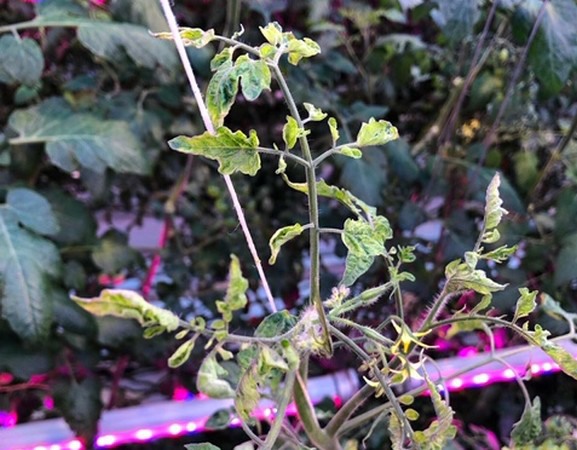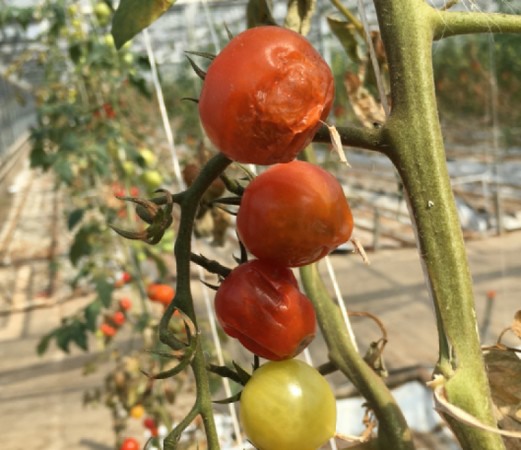AHDB commissioned Dave Kaye to carry out three case studies with UK growers who have had a ToBRFV outbreak on their sites, to explore their first-hand experience, including how the virus was found and reported, the symptoms that were observed, the pattern of spread, and how the outbreak was managed. The goal of these case studies was to allow us to build on our understanding of the virus, continue to develop best practice guidance for its management, and make recommendations for future ToBRFV research and surveillance activity.
Grower site one
Infection was confirmed after samples were sent to the Plant Health and Seed Inspectorate (PHSI) and a diagnostic laboratory outside the UK.
Symptoms started to develop soon after arrival on site in only one of the three varieties planted (classic cherry tomato) and included deformed, twisted nettled heads and needle-like leaves. The symptom distribution and progression indicate the entire crop was infected at the same time and it is possible that the recirculating irrigation system may have contributed to virus spread.
All the plants from the block (with and without symptoms) were removed before fruit set to prevent further infection. Before site disinfection, infected material was disposed of via landfill. No outbreaks developed in the subsequent crop and the site was declared free from ToBRFV in June 2020.

Symptoms of ToBRFV on tomato leaves - chlorosis, mottling, necrosis and drooping. Image source anonymous, used with permission.
Grower site two
This outbreak occurred sequentially across two compartments that were under construction and virus spread may have been facilitated by contractors on site. PHSI statutory surveillance confirmed infection in March 2020.
The symptoms occurred in the mature crops and were the same in each compartment. In addition to showing similar symptoms to those observed at site one, they also featured reduced fruit and truss size, fruit abortion and weaker stems with reduced diameter. Two-thirds of the crop was symptomatic by the time the crop was removed. Symptom expression seemed to coincide with the switching on of LEDs.
The infected material was removed on a conveyor system, baled and incinerated on site (granted under an exemption licence). All equipment and site architecture were thoroughly cleaned with Jet 5 (1:125 rate), Unifect G (1:25 rate), followed by fogging with Jet 5 (1:12 rate with 1 litre of Jet 5 per 200 m3 of space) carried out by staff.
Since this outbreak was reported in this case study, grower site 2 has unfortunately experienced a secondary outbreak. For more information on the progression of this outbreak and how it was managed, please read this update.

ToBRFV symptoms - deformed, twisted, nettled heads and leaves. Image source anonymous, used with permission.
Grower site three
At this site, no symptoms were visible before the virus was confirmed by PHSI statutory surveillance.
Subsequent symptoms included leaf lesions and chlorosis, leaf tissue death, lesions on the centre of stems, reduced fruit and truss size, and rugose fruit symptoms, coincided with water stress caused by an irrigation breakdown. These initially developed in patches around the glasshouse, suggesting the infection was not introduced during propagation. A possible route of infection could have been via the import of fruit from Europe to the neighbouring packhouse.
The crop was terminated early with 100% of the crop symptomatic by this stage, and the glasshouse was temporarily closed after the final harvest. Infected material was removed and incinerated on site (granted with an exemption licence). The disinfection protocol was being planned at the time of the case study.

ToBRFV rugose symptoms on fruit exacerbated by irrigation breakdown. Image source anonymous, used with permission.
 AHDB
AHDB
